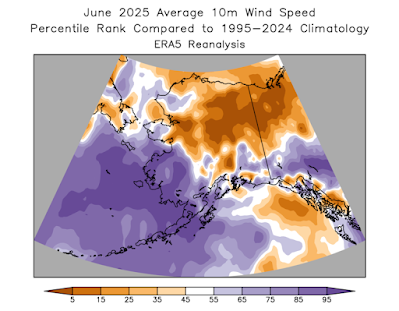June was an interesting month for global climate, and Alaska's weather reflected the larger-scale patterns that unfolded.
One of the most striking aspects was that unusually strong ridges developed in the mid-latitudes of the Northern Hemisphere - particularly across the North Pacific from Japan to the US West Coast, and across the North Atlantic and southern Europe. Record heat waves occurred in western Europe and Japan, and it was the hottest June on record in both regions.
In contrast to the mid-latitude ridging, the atmospheric pressure was generally lower than normal in the Arctic, and especially from eastern Russia to the Bering Sea and across the northern North Atlantic and northern Europe. This "see-saw" of MSLP is typical of the Arctic Oscillation, and June characterized a positive AO phase.
The Arctic Oscillation typically refers to conditions in the troposphere and is not always directly linked to the stratospheric flow above, but in this case the circulation anomaly extended well up into the stratosphere. In the lower stratosphere, for example at 100mb pressure, there was a similar ring of above-normal heights (pressure) in the mid-latitudes and low heights near Greenland:
In tandem with the pressure anomaly, the 100mb circumpolar westerly winds at 60°N were the strongest on record for June. Think of it as a vortex of counter-clockwise rotating air aloft that was moving faster than ever observed before (in June) up at about 50-60,000 feet.
What relevance does this have for Alaska? Well, the low pressure over the Bering Sea involved unusual storminess, so it was a very windy, cloudy, and wet June for Aleutian and Bering Sea communities. Also, with southern Alaska located squarely in the zone of enhanced westerly winds to the north of the Pacific ridge, the wet weather traveled eastward across the Gulf Coast to the northern Panhandle. It was also unusually cool in southern and especially Southeast Alaska, with warm air unable to migrate up from the south. Here are my usual monthly percentile rank maps based on NCEI data (top two maps) and ERA5 data (maps below):






One might expect that low pressure in the Arctic (positive AO phase) would also produce windy and perhaps wet weather for Arctic Alaska, but in fact the classical positive AO setup at this time of year tends to allow a localized ridge to the north of Alaska, and that's what we saw in June (see the first map in this article). As a result, the North Slope was mostly calm, sunny, and generally warm and dry. Sunny, warm, and calm conditions also extended over most of the northern and eastern interior - but this refers to monthly averages, and there was also a tremendous amount of lightning during the month. Here's a map of lightning strikes during the month, showing very widespread activity:
With over 93,000 ground strikes, this was the second most active June recorded by the ALDN (2012-present); the most active June was in 2015, with about 103,000 strikes; but that year the activity was concentrated farther south, and especially in the southwestern interior:
I'll be doing more analysis of this year's lightning activity in a subsequent post.
It's also worth commenting on North Pacific SSTs, which have reached extreme levels of unusual warmth from Japan eastward in recent days (responding to the strong ridge across the North Pacific). Check out the development of extreme warmth between early June and early July:
This is an enormous marine heat wave, perhaps the most expansive and anomalous on record in recent decades; I'll have to do some objective analysis to quantify this. The warmth in this region is characteristic of a negative PDO phase, and so the PDO index has plummeted to record negative values in recent days (see below). We might say this is also part of the reason for the cool June in southern Alaska.





































